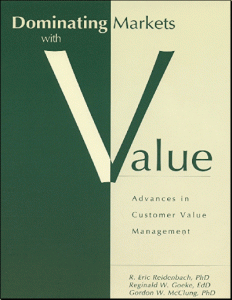Dominating Markets with Value will show you how value driven, nationally known organizations have harnessed the power of customer value analysis through a systematic and logical process of customer value management. The book provides a long needed approach to measuring customer value that can actually drive your Six Sigma initiatives to increase market share and top line revenues. Readers will be treated to a comprehensive case describing how one of the American Productivity and Quality Center’s Best Practice Partners has used customer value management to greatly increase their market share and their profitability.
Benefits of this eBook
- Create a powerful planning process designed to take advantage of your competitors’ vulnerabilities.
- Redesign your value stream to maximize value delivery at the lowest possible cost.
- Unleash the power of your sales force and increase customer loyalty.
This book is designed to lay out a comprehensive customer value management framework. We have divided the book into five sections.
Section I: Provides an overview of Customer Value Management.
- Chapter 1 lays out a rational for Customer Value Management. Issues related to customer satisfaction and the management of these systems are discussed. The chapter concludes with a framework for Customer Value Management.
- Chapter 2 we discuss how the value infrastructure (vision/ mission/culture) operates to provide the supporting framework for the successful implementation of a customer value strategy. How an organization integrates its vision, mission and culture to focus on customer value has a strong impact on the success of its customer value initiative, market share, and profitability.
- Chapter 3 we outline key value propositions and detail expectations from the Value Performance Chain. This is a customer value boot camp designed to provide a common platform for readers to understand the Customer Value Management framework.
Section 2: Addresses the Market Value Information component of CVM.
- Chapter 4 deals with the issue of providing focus and prioritization of key opportunities for organizational growth. In this chapter we will offer a framework for developing the necessary focus for targeting your customer value efforts. The premise is that not all growth opportunities are equal. Some are better than others, and it is incumbent upon management to identify those key opportunities.
- Chapter 5 takes on the issue of converting information into knowledge. How do you identify the important value drivers? How does your organization‘s competitive value proposition stack up against those of your competitors? How loyal is your customer base? What are the revenue and cost implications of loyalty? These are the types of questions that will be addressed in this chapter.
Section 3: Dives into the strategic planning component of the Customer Value Management System.
- Chapter 6 describes the importance of systematic environmental scanning. Here we will examine the role that environmental variables, outside the control of the organization, have on the constantly evolving customer definitions of value.
- Chapter 7 provides a mechanism for examining market needs, strengths and weaknesses, and the identification of market opportunities based upon Customer Value Analysis (CVA).
- Chapter 8 describes how to translate value differentiation opportunities into a focused product/market strategy. This chapter also addresses the methodology for identifying specific marketing objectives in order to capitalize on key value differentiation opportunities.
- Chapter 9 outlines the development of action programs to achieve the marketing objectives and the development of a budget to assess the cash flow contribution of the plan.
Section 4: Is devoted to the significant targeted improvement process. We will focus on issues of customer recovery, Value Stream Analysis, failure analysis, and the deployment process.
- Chapter 10 examines how to take the lessons learned from failure and turn them in to future successes. Companies that research in the lab of lost customers can learn a lot about retaining profitable customers.
- Chapter 11 focuses on Value Stream Analysis. The focus is on application of the techniques for the identification of critical areas of opportunity for enhancing value delivery.
- Chapter 12 is a chapter discussing the mechanics of redesigning Value Streams to enhance organizational performance. A nine-step process is outlined.
Section 5: The book concludes with a case study of a company identified by the American Productivity and Quality Center (APQC) as representing best practices in Customer Value Management.
- The case study describes how that ?Best Practice? organization began the transition into CVM, how it has integrated and aligned all three components of a CVM system under a guiding value vision, and the business performance results it has achieved in the process.

